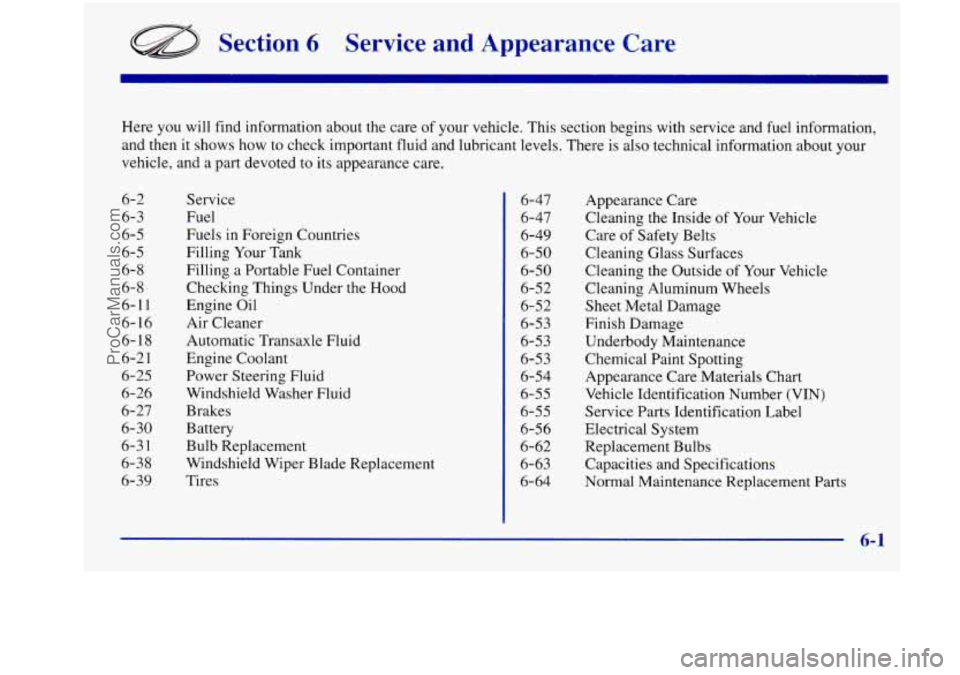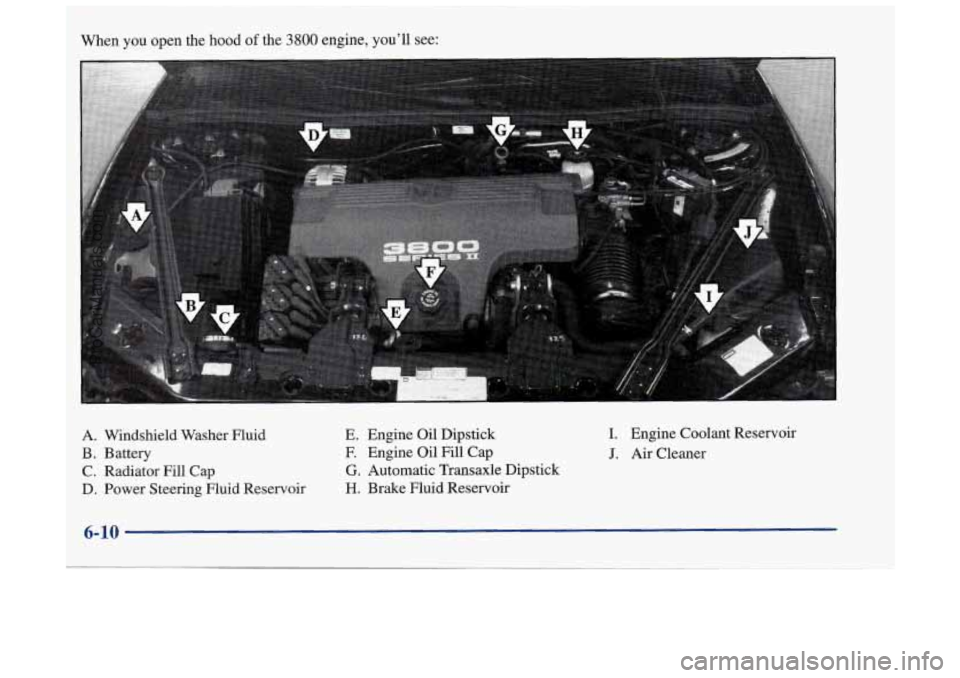brake fluid OLDSMOBILE INTRIGUE 1998 Owners Manual
[x] Cancel search | Manufacturer: OLDSMOBILE, Model Year: 1998, Model line: INTRIGUE, Model: OLDSMOBILE INTRIGUE 1998Pages: 340, PDF Size: 17.93 MB
Page 172 of 340

And, if your tires don’t have much tread left, you’ll get
even less traction. It’s always wise to go slower and be
cautious if rain starts to fall while you are driving. The
surface may get wet suddenly when your reflexes are
tuned for driving
on dry pavement.
The heavier the rain, the harder
it is to see. Even if your
windshield wiper blades are in good shape, a heavy rain
can make it harder
to see road signs and traffic signals,
pavement markings, the edge of the road and even
people walking.
It’s wise
to keep your windshield wiping equipment in
good shape and keep your windshield washer tank filled
with washer fluid. Replace your windshield wiper
inserts when they show signs of streaking or missing
areas on the windshield, or when strips of rubber start
to separate from the inserts.
Driving too fast through large water puddles or even
going through some
car washes can cause problems, too.
The water may affect your brakes. Try to avoid puddles.
But if you can’t, try
to slow down before you hit them.
4-18
ProCarManuals.com
Page 178 of 340

If you drive regularly in steep country, or if you’re
planning to visit there, here are some tips that can make
your trips safer and more enjoyable.
Keep your vehicle in good shape. Check all fluid
levels and also the brakes, tires, cooling system
and transaxle. These parts can work hard on
mountain roads.
Know how to go down hills. The most important
thing to know is this: let your engine do some of the
slowing down. Shift to
a lower gear when you go
down a steep or long hill.
1
If you don’t shift down, your brakes could
get
so hot that they wouldn’t work well. You
would then have poor braking or even none going
down
a hill. You could crash. Shift down to let
your engine assist your brakes on
a steep
downhill slope. Coasting downhill in NEUTRAL
(N) or with
the ignition off is dangerous. Your brakes will
have to do all the work
of slowing down. They
could get
so hot that they wouldn’t work well.
You would then have poor braking
or even none
going down
a hill. You could crash. Always have
your engine running and your vehicle in gear
when you go downhill.
Know how to go uphill. You may want to shift down
to a lower gear. The lower gears help cool your engine
and transaxle, and you can climb the hill better.
0 Stay in your own lane when driving on two-lane
roads in hills or mountains. Don’t swing wide or cut
across the center of the road. Drive at speeds that let
you stay in your own lane.
0 As you go over the top of a hill, be alert. There could be
something in your lane, like a stalled car or an accident.
0 You may see highway signs on mountains that warn of
special problems. Examples are long grades, passing or
no-passing zones, a falling rocks area or winding
roads. Be alert to these and take appropriate action.
4-24
ProCarManuals.com
Page 191 of 340

When You Are Ready to Leave After
Parking on a Hill
1. Apply your regular brakes and hold the pedal down
while you:
Start your engine;
Shift into a gear; and
Release the parking brake.
2. Let up on the brake pedal.
3. Drive slowly until the trailer is clear of the chocks.
4. Stop and have someone pick up and store the chocks.
Maintenance When Trailer Towing
Your vehicle will need service more often when you’re
pulling a trailer. See the Maintenance Schedule for more
on this. Things that are especially important in trailer
operation are automatic transaxle fluid (don’t overfill),
engine oil, drive belts, cooling system and brake
adjustment. Each of these
is covered in this manual,
and the Index will help you find them quickly. If you’re
trailering, it’s a good idea to review this information
before you start your trip.
Check periodically to see that all hitch nuts and bolts
are tight.
Engine Cooling When Trailer Towing
Your cooling system may temporarily overheat during
severe operating conditions. See “Engine Overheating”
in the Index.
4-37
ProCarManuals.com
Page 229 of 340

Section 6 Service and Appearance Care
Here you will find information about the care of your vehicle. This section begins with service and fuel information,
and then it shows how
to check important fluid and lubricant levels. There is also technical information about your
vehicle, and a part devoted to its appearance care.
6-2 Service
6-3 Fuel
6-5 Fuels in Foreign Countries
6-5 Filling Your Tank
6-
8 Filling a Portable Fuel Container
6-
8 Checking Things Under the Hood
6-1 1 Engine Oil
6-
16 Air Cleaner
6-18 Automatic Transaxle Fluid
6-2
1 Engine Coolant
6-25 Power Steering Fluid
6-26 Windshield Washer Fluid
6- 27 Brakes
6-30 Battery
6-38 Windshield Wiper Blade Replacement
6-3
1 Bulb Replacement
6-39 Tires 6-47
6-47
6-49
6-50
6-50
6-52
6-52
6-53
6-53
6-53
6-54
6-55
6-55
6-56
6-62
6-63
6-64 Appearance
Care
Cleaning the Inside of Your Vehicle
Care of Safety Belts
Cleaning Glass Surfaces
Cleaning the Outside of Your Vehicle
Cleaning Aluminum Wheels
Sheet Metal Damage
Finish Damage
Underbody Maintenance Chemical Paint Spotting
Appearance Care Materials Chart
Vehicle Identification Number (VIN)
Service Parts Identification Label
Electrical System
Replacement Bulbs Capacities and Specifications
Normal Maintenance Replacement
Parts
6-1
ProCarManuals.com
Page 236 of 340

~ Filling a Portable
Fuel Container
I
I
1 1 Never fill a portable fuel container while it is in
your vehicle. Static electricity discharge from the
container can ignite the gasoline vapor. You can
I be badly burned and your vehicle damaged if this
i occurs. To help avoid injury to you and others:
Dispense gasoline only into approved
containers.
0 Do not fill a container while it is inside a
vehicle, in a vehicle’s trunk, pickup bed or
on any surface other than the ground.
inside of the fill opening before operating
the nozzle. Contact should be maintained
until the filling
is complete.
I Bring the fill nozzle in contact with the
~ I 0 Don’t smoke while pumping gasoline.
Checking Things Under the Hood
An electric fan under the hood can start up and
injure you even when the engine
is not running.
Keep hands, clothing and tools
away from any
underhood electric fan.
Things that burn can get on hot engine parts and
start a fire. These include liquids like gasoline,
oil, coolant, brake fluid, windshield washer and
other fluids, and plastic or rubber. You or others
could be burned. Be careful not to drop or spill
things that
will burn onto a hot engine.
6-8
ProCarManuals.com
Page 238 of 340

I. Engine Coolant Reservoir
J. Air Cleaner
Windshield
Washer Fluid
Battery
Radiator Fill Cap
Power Steering Fluid Reservoir E.
Engine Oil Dipstick F. Engine Oil Fill Cap
G. Automatic Transaxle Dipstick
H. Brake Fluid Reservoir
A.
B.
C.
D.
6-10
ProCarManuals.com
Page 247 of 340

To get the right reading, the fluid should be at normal
operating temperature, which is
180 OF to 200" F
(82°C to 93°C).
Get the vehicle warmed up by driving about
15 miles
(24
km) when outside temperatures are above 50°F
(10°C). If it's colder than 50°F (lO"C), you may have
to drive longer.
Checking the Fluid Level
Park your vehicle on a level place. Keep the
engine running.
With the parking brake applied, place the shift lever
in PARK
(P).
With your foot on the brake pedal, move the shift
lever through each gear range, pausing for about
three seconds in each range. Then, position the shift
lever in PARK (P).
Let the engine run at idle for three to five minutes. Then, without shutting
off the engine, follow
these steps:
The transaxle fluid dipstick is the red loop near the back of the engine.
1. Pull out the dipstick and wipe it with a clean rag or
paper towel.
2. Push it back in all the way, wait three seconds and
then pull it back out again.
6-19
ProCarManuals.com
Page 255 of 340

Brakes
Brake Fluid
goes back up. The other reason is that fluid is leaking out
of the brake system. If it is, you should have your brake
system fixed, since a leak means that sooner or later your
brakes won’t work
well, or won’t work at all.
So, it isn’t a good idea to “top off’ your brake fluid.
Adding brake fluid won’t correct
a leak. If you add fluid
when your linings are worn, then you’ll have too much
fluid when you get new brake linings. You should add
(or remove) brake fluid,
as necessary, only when work is
done on the brake hydraulic system.
Your brake master cylinder reservoir
is here. It is filled
with
DOT-3 brake fluid.
There are only two reasons why the brake fluid level
in the
reservoir might go down. The first is that the brake fluid
goes down to
an acceptable level during normal brake
lining wear.
When new linings are put in, the fluid level
If’ you have too much brake fluid, it can spa on the
engine. The fluid
will burn if‘ the engine is hot
enough. You or others could be burned, and
your
vehicle could be damaged. Add brake fluid only
when work
is done on the brake hydraulic system.
When your brake fluid falls to a low level, your brake
warning light will come on. See “Brake System Warning
Light”
in the Index.
6-27
ProCarManuals.com
Page 256 of 340

What to Add
When you do need brake fluid, use
only DOT-3 brake
fluid -- such as Delco Supreme ll@ (GM Part
No. 12377967). Use new brake fluid from a sealed
container only.
Always clean the brake fluid reservoir cap and
the area
around the cap before removing it. This
will help keep
dirt from entering the reservoir.
With the wrong kind
of fluid in your brake
system, your brakes may
not work well, or they
may not even work at all. This could cause
a
crash. Always use the proper brake fluid.
-- 1
NOTICE:
Using the wrong fluid can badly damage
brake system parts. For example, just
a few
drops of mineral-based oil, such as engine
oil, in your brake system can damage brake
system parts
so badly that they’ll have to be
replaced. Don’t let someone put in the
wrong kind of fluid.
0 If you spill brake fluid on your vehicle’s
painted surfaces, the paint finish can be
damaged. Be careful not
to spill brake fluid
on your vehicle. If you do, wash it off
immediately. See “Appearance Care” in
the Index.
6-28
ProCarManuals.com
Page 310 of 340

Part D: Recommended Fluids
and Lubricants
NOTE: Fluids and lubricants identified below by name,
part number or specification may be obtained from
your retailer.
USAGE
Engine Oil
Engine Coolant
FLUIDLUBRICANT
Engine Oil with the American
Petroleum Institute Certified For
Gasoline Engines “Starburst”
symbol of the proper viscosity.
To
determine the preferred viscosity
for your vehicle’s engine, see
“Engine Oil” in the Index.
50/50 mixture of clean water
(preferably distilled) and use only
GM Goodwrench@ DEX-COOL@
or Havoline@ DEX-COOL@
Coolant. See “Engine Coolant”
in
the Index.
USAGE
Hydraulic Brake
System
Power Steering System
Automatic
Transaxle
Key Lock Cylinders
Windshield Washer Solvent
FLUIDLUBRICANT
Delco Supreme 11 @ Brake Fluid
(GM Part
No. 12377967 or
equivalent
DOT-3 Brake Fluid).
GM Power Steering Fluid (GM
Part No. 1052884 - 1 pint,
1050017
- 1 quart, or equivalent).
DEXRON@-I11 Automatic
Transmission Fluid.
Multi-Pu ose Lubricant,
Superlube (GM Part
No.
12346241 or equivalent).
GM Optikleen@ Washer Solvent
(GM Part
No. 1051515) or
equivalent.
%
7-18
ProCarManuals.com